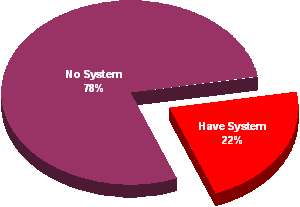Why do 88% of Ideas Fail to Make it to Market?
The reason 88% of ideas fail to make it to market is companies have no system to turn ideas into marketable innovations.
Even though 87% of CEOs list innovation as a Top 5 priority 78% of companies have NO INNOVATION SYSTEM.

Do you think it’s a coincidence that 88% of ideas fail to make it to market when 78% of companies lack any innovation system?
Innovations produce 300% larger return on investment than capital investments. You can clearly see why CEO’s list innovation as a top priority. Innovation is the best source of profits.
Why don’t more companies have an innovation system?
Google is an Innovation Amateur
First, let me say I love Google. I was an early Google adopter and still recommend Google products. Analytics is so good that I dumped the custom tools I spent 2 years developing and now just use Google Analytics. And when Google Video was starting out I worked with them publishing videos and making suggestions to improve their tools.
I believe Google is currently the most innovative company in the world. And that is terribly sad.
Marissa Mayer at Business Week praises, “Google’s Idea Factory”. I like the insight offered af Innosight.com. Google’s Culture of Innovation as being their key to success. I was struck by “eight brainstorming sessions each year with 100 engineers” being called rigor and discipline.
When you think of a factory do you picture creative brainstorming? Or do you picture a highly organized system with clock like precision? Which do you think is more likely to deliver consistent high quality results? The random willy-nilly brainstorming approach or a well planned mapped out highly efficient system?
Even though Google has a system for soliciting and selecting good ideas it’s not much more than a suggestion box with a bunch of smart people stuffing notes in it. Sure Google increases their chances of finding a gem by casting a wide net for ideas by allowing engineers 1 day a week to work on new ideas but that still is hardly organized. This is the innovation equivalent of playing the lottery. So far Google has gotten lucky by snagging the low hanging fruit that others were just too lazy to reach.
Do you really think throwing more people and money at the problem is the best you can do? I certainly don’t.
If the folks at Google, or you, want to have a real Idea Factory you need to quickly
- Identify all possible innovations
- Organize each innovation by value
- Predict future innovations
- Follow an accurate map grabbing each innovation in order
I can hear frustrated engineers, product managers, and marketers all over the world screaming “Sure, but that’s impossible”. And they used to say the same thing about human flight, running the 4-minute mile and going to the moon.Just like it’s possible to fly or go to the moon and run a 4-minute mile, all you need is the right system and to believe it’s possible. And spreading the news about the system that makes it possible is why I write this blog.
I’ve worked with some innovation heavy hitters such as Apple, Microsoft, Hewlett Packard and Nintendo. I’ve also tried and failed to move some giants like GM out of the noose they put their own neck into. But until a few years ago I never knew the real system for innovation. Now that I do, I want everyone to benefit.
I would love to just spell all the entire OutCompete System here and now, but as can imagine, such a powerful system requires more than a few paragraphs to describe. Keep reading my blog and I’ll explain it in more detail. For now, I’ll give you a quick overview.
By using recently discovered laws of information and systems theory we can describe all possible ways of achieving a goal. Read my article “How to Predict Future Innovation” to learn the first step. As it turns out there always at least 15 solutions for any goal and on average there are 50,625 possible solutions.
If you’re not heavy into math just hold on, for a bit while I explain something to the propeller heads.
All systems can be described with approximately 7 conditions. If it takes more than 7 you’re probably describing a system made of sub systems. Furthermore, any of those conditions fits one of 15 categories. OK, fellow geeks, 15 to the power of 7 is 170,859,375. That is a whole bunch of possible innovations. But if we consider most systems only have 4 conditions that is 15^4 = 50,625.
So the OutCompete System identifies those 50,625 possible innovations. That still is a very large number but look at how we found that number. It’s totally organized by 4 condition and 15 alternatives. Now you have an organized list you can run through. No hunt and peck guessing. It’s totally predictable.
OutCompete doesn’t stop with providing a list of innovations it ranks them and literally gives you a map of step for each innovation in order of benefit to you.
Action Items
- List the innovation techniques you use.
- Count the number of innovations you generate per “brain storming session”.
- Think of at least one innovation your competitor could crush you with.
- Calculate the benefit of 15 immediately possible innovations.



 Predictive Innovation Training
Predictive Innovation Training Predictive Innovation: Core Skills Book
Predictive Innovation: Core Skills Book RoundSquareTriangle.com
RoundSquareTriangle.com